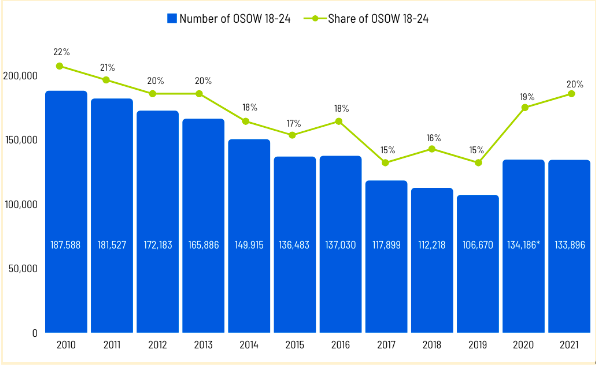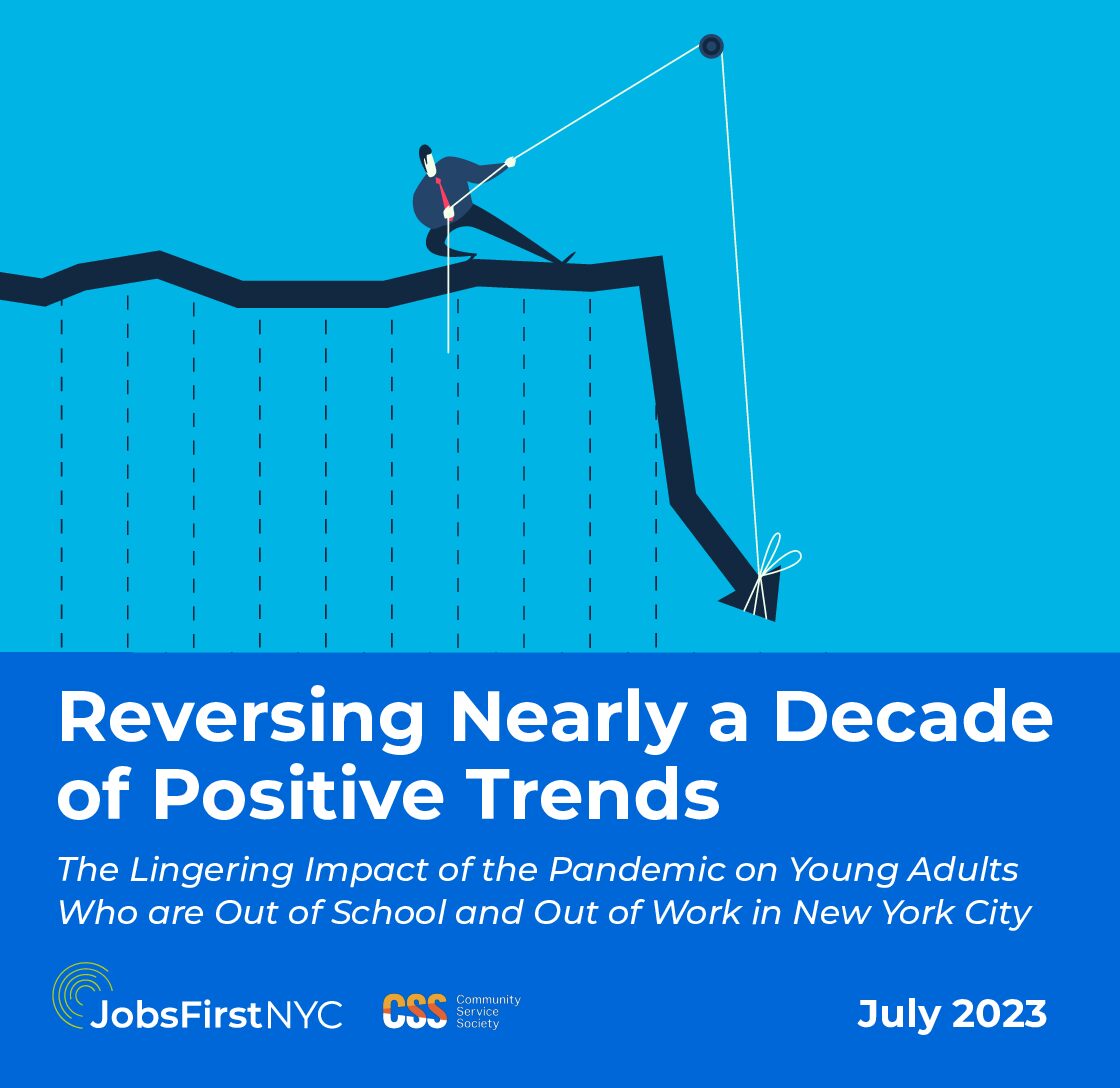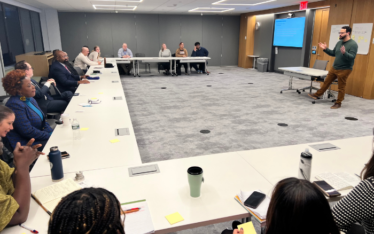In New York City, despite a decade-long trend of increasing gains in the labor market and rising educational attainment, the proportion of 16- to 24-year-olds who are both out of school and out of work has skyrocketed since the COVID-19 pandemic. Such a trend reversal further pushes this already vulnerable population toward the fringes of our economy and society. This brief examines the out-of-school, out-of-work population from a variety of socioeconomic and demographic perspectives, identifies programs and policies that seek to address the needs of this population, and includes recommendations to ensure that young adults who are out of school and out of work are put back on track to economic security.
What Current Data Says about NYC’s Young Adults Who Are Out of School and Out of Work in NYC
In the years immediately preceding the pandemic, 2018 and 2019, 13.1% of all 16- to 24-year-olds were neither in school nor part of the labor force—the lowest rate since 2010. Post-pandemic, that share has risen to 16%.
There are 138,029 young people who are out of school and out of work in New York City. In absolute terms, an additional 25,500 16- to 24-year-olds have joined the out-of-school, out-of-work category in New York City. This increase is especially noteworthy since the overall population of 16– to 24-year-olds has decreased over the same period. In 2021, the out-of-school, out-of-work rate for 18- to 24-year-olds was 20%–slightly higher than the rate in 2005, when JobsFirstNYC was founded to address this crisis.
Moreover, this negative shift occurs at a critical time in which the upward mobility of young adults who are out of school and out of work (OSOW) depends on attaining a quality education while concurrently developing a rich foundation of relevant skills necessary to successfully engage with today’s job market demands.
Figure 1. Count and share of NYC’s out-of-school, out-of-work population, 2010–2021

Source: American Community Survey Public Use Microdata Sample for 2010 to 2021
Key Findings from the Data Brief
The data on young adults who are out of school and out of work uncovered key insights about demographics, neighborhoods, education, and the labor market.
What is the Current Population of Young Adults who are Out of School and Out of Work in NYC?
- The total number of young adults who are out of school and out of work has increased significantly since the year prior to the pandemic, reversing a decade-long trend. This increase is especially concerning given that the overall population of 16- to 24-year-olds has decreased over the same period.
- The share of young adults who are out of school and out of work increased across all races and ethnicities during the pandemic. Black and Latino/a/x/Hispanic communities had the largest increases.
- Continuing pre-pandemic trends, young adults who are out of school and out of work are more likely to come from under-resourced households, especially from Black and Latino/a/x/Hispanic communities.
- The gap between the male and female out-of-school, out-of-work rates was narrowing pre-pandemic but has since started to widen. Young adults who are out of school and out of work are now more likely to be male.
Where do young adults who are out of school and out of work live?
- The neighborhoods with the overall highest share of the out-of-school, out-of-work population are: Brownsville & Ocean Hill (Brooklyn); Hunts Point, Longwood, & Melrose (Bronx); East Harlem and Central Harlem (Manhattan); and Morris Heights, Fordham South & Mount Hope (Bronx).
- The neighborhoods experiencing the largest increases in the population of young adults who are out of school and out of work since the start of the pandemic are: Astoria & Long Island City (Queens); Hamilton Heights, Manhattanville, & West Harlem (Manhattan); Concourse, Highbridge, & Mount Eden (Bronx); Riverdale, Fieldston & Kingsbridge (Bronx); and Chelsea, Clinton, and Midtown (Manhattan).
- Out-of-school, out-of-work rates in every borough have increased since before the pandemic. Manhattan and Queens have experienced the largest increases, where there are also fewer city workforce program sites.
What is the state of educational access and attainment?
- High school graduation rates have remained steady throughout the pandemic for all races/ethnicities, and the gap between races/ethnicities is narrowing. High school stop-out rates have also continued on a downward trend citywide and for all racial/ethnic communities.
- College attendance rates of Black and Latino/a/x/Hispanic young adults have improved over the last decade.
- 75% of young adults who are out of school and out of work lack any college education, restricting their opportunities in the job market.
- Young adult first-time enrollment into City University of New York (CUNY) Associate’s degree programs were the lowest they’d been in a decade in Fall 2020, at 18,250 students, and reduced even further in Fall 2021 to 14,600 students.
- Young adult retention rates for the Fall 2020 cohort of CUNY Associate’s degree programs across all institutions were 73% for one-semester and 56% for one-year following matriculation. Nearly half of students who began in Fall 2020 were not retained through one year of Associate’s Degree programs.
- Young adult enrollment into CUNY non-degree programs is higher in 2020 and 2021 compared to a decade prior, though marginally lower than enrollment in 2019, the peak year of the decade.
What are the trends in the labor market?
- Young people are primarily employed in retail, restaurants and hotels. The distribution of employees across industries remains largely the same in the wake of the pandemic. Industrial sectors where young adult employment tends to be highest have yet to fully return to their pre-pandemic levels.
- Young adult wage growth has been slow relative to growth in wages for all workers, and the share of workers in part-time work has increased.
- The 2021 youth unemployment rate of 10.3% exceeds the unemployment rate for the overall population, which is 6%. For young black workers, unemployment is 31%, while for young Latinx workers, unemployment is 26%.
- The employment rate for 16- to 24-year-olds has fallen among both full-time and part-time workers, but the decrease is greater among those employed full time. Across the entire population, the pandemic caused the share of full-time workers to fall and the share of part-time workers to rise. Additionally, young workers are increasingly seeking out work in the gig economy.
Median wages for full-time workers are $28,138 for 16- to 24-year-olds and $57,554 for the entire population. The median wages of youth workers vary less by race and ethnicity relative to the entire population.
Recommendations to Meet the Economic Needs of Young People
The following five recommendations are aimed at meeting the challenges described above. These recommendations echo calls made in other JobsFirstNYC publications regarding the need for partnerships, institutional change and systemic changes to ensure that New York City’s young adults and community members can access economic mobility.
Recommendations #1 and #2 are from Barriers to Entry: Fewer Out-of-School, Out-of-Work Young Adults, as Warning Signs Emerge, a study examining how young adults aged 18–24 are faring in the New York City labor market.
#1: Address the warning signs concerning part-time, low-wage work.
Steady growth in part-time, low-wage jobs creates long-term economic insecurity and uncertainty. New York City needs to invest in and strengthen opportunities for young adults to access good-paying quality jobs, while also building more intentional opportunities for part-time, low-wage workers to connect to training that will put them on a path to economic mobility. This includes longer post-placement services and more opportunities for part-time workers to continue developing their skills. Furthermore, New York State should begin the policy process to build a portable benefits framework to provide the growing number of part-time workers with greater protections and financial security.
#2: Support neighborhood partnership development.
JobsFirstNYC has spearheaded a number of place-based partnerships — localized solutions that respond to the unique needs of communities with high numbers of OSOW young adults. These partnerships include the Lower East Side Employment Network, the Brownsville Hub Cooperative (Brooklyn), YES Bed-Stuy (Brooklyn), Youth WINS (Staten Island), and the Jerome Avenue Revitalization Collaborative (Bronx).
Recommendations #3 and #4 are from JobsFirstNYC’s report Equitable Recovery for Young Adults: An Agenda for Young Adult Workforce Development in New York City, which provides a set of citywide policy priorities rooted in the needs of young people, the perspectives of on-the-ground practitioners, and the literature on successful policies and interventions.
#3: Prioritize economic mobility and pathways to prosperity for historically marginalized and disproportionately harmed communities.
New York City’s young adult workforce system stakeholders can make significant, measurable progress toward this recommendation by: encouraging participation in young adult workforce programs; implementing systems change strategies; centering young adults in planning processes; and prioritizing economic mobility and prosperity.
#4: Create a seamless continuum of integrated services across education and workforce development institutions.
New York City’s young adult workforce system must ensure that young people can utilize multiple points of entry and experience uninterrupted transitions between programs, systems, and service providers. This can be done by: providing early career exposure; leveraging existing resources for support; integrating wraparound support programs; increasing the availability of bridge programs; reimagining education pathways; and making credentials easily attainable.
#5: Implement additional policy changes.
- Expand the Earned Income Tax Credit to 18- to 24-year-old workers.
- Substantially increase the minimum wage. While the minimum wage in New York City is set to rise incrementally over the next three years, inflation, poverty, and widespread economic instability may continue to leave many young adults in New York City financially insecure.
- Strengthen wage equity policies for young adult workers by protecting against wage theft and increasing the reach and enforcement of anti-discrimination policies and workplace protections.
- Increase investment in initiatives that support young men. Given the alarming rise in unemployment rates among young men in New York City, particularly those of color, it is critical to prioritize investment in programs that support this population.
JobsFirstNYC’s most recent report, 1 in 4 Young Adults in New York City Were Out of School and Out of Work in 2020, relied on limited data from the Current Population Survey due to the impact of COVID-19 and the delay of 2020 ACS data release. This data brief presents updated data from the American Community Survey (ACS), which provides a more complete and reliable picture of the years affected by the pandemic.
Call to Action
This data brief demonstrates that in the wake of nearly a decade of gains in connecting young adults to school and work, the COVID-19 pandemic has reversed this trend, with devastating consequences for New York City’s young adults and the communities in which they live.






